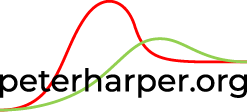Methodology, Research, Design
By 'methodology' I mean the rather special methods I have adopted to pursue my enquiries. It is probably closest in spirit to investigative journalism. It is not particularly 'academic' in that it does not always comply with the rules (either formal or informal) of peer-reviewed research.
I try hard to step back and see the big picture. I am aiming at what might be called 'verisimilitude': fidelity to the underlying reality. Precision is not as important as getting the right ballpark. As Keynes once remarked, it is better to be vaguely right than precisely wrong.
Consider the squares here. A is the correct underlying reality, but might be hard to measure exactly. Attempts to apply formal and precise methods might produce a crisply specified value C. This looks impressive, but I will argue that the fuzzy estimate B is better.
Getting a fuzzy image of the whole tells you which pixels might be the most important to work on. Big Picture is what we do best. Academia is better at pixels. and might start systematically at top left, working down. Armed with a fuzzy image, you know where best to look more closely.
Generally I prefer to capture the general size and shape of a problem, and slowly improve precision, rather than build up a picture from exactly specified 'pixels', which is often the preferred academic option. This approach is illustrated by the image on the left.
In the formal research world, one is commonly rewarded for successfuly solving a problem, but a natural effect of this is to encourage the selection of easily-solvable problems, rather than important problems that need solving. At CAT there was a preference to identify large, perhaps difficult or so-called 'wicked' problems and try to provide approximate answers where perhaps others fear to tread.
We were not expected to conform to the same standards as university researchers, and could therefore play a complementary role, generating suggestive pilot-level results that others might wish to take on. This is particularly the case for naturally interdisciplinary problems, where we have tended to behave more like 18th century 'natural philosophers' rather than modern scientists. We are also able to investigate areas where there are cultural taboos preventing mainstream enquiry, at least in order to provide some controlled data where otherwise there are none at all.
Having said all this, I should emphasise all this is my own personal take on the process of research at CAT, and others are bound to have different views. As Head of Research and Innovation for ten years I was entitled to develop specific methodologies, but these were never adopted as official policy. It is interesting to note that I was criticised both for trying to quantify things that should not be measured, and for being insufficiently precise.
Distinctive Patterns of Research at CAT 2007 (doc)
Doing the Numbers: The Art of Rough Calculations 1998 (doc)
Recent Research at CAT: Looking Sideways 2012 (ppt)
Tackling an interdisciplinary problem: The case of home composting 2007 (ppt)
Sometimes, far more research is implied than we can ever hope to do. This is a feature of new paradigms: that many new lines of research are suggested. The following is a rough list of follow-up lines of enquiry suggested by the land-use proposals of Zero-Carbon Britain 2030.
Research issues suggested by ZCB Land Use analysis 2011 (doc)
As a hobby now, I continue to observe the world of the small, perhaps with a view to improving benign methods of pest control. It’s unsystematic, but accumulations of such informal observations might lead somewhere one day. There remain puzzles that entomologists cannot answer.
SYSTEMS AND DESIGN
The natural interdisciplinary of CAT's work encouraged patterns of thought that cross disciplinary boundaries, and indeed a search for Big Principles. Do such principles really exist and could they be truly useful?
Historically one of the most ambitious proposals for general priciples has been System Theory in numerous forms, and naturally I found myself engaged with it. Here are some results:
Systems and Sustainability 2011 (ppt)
The word 'design' has achieved an astonishing variety of applications, and I often wondered whether there were any general principles that would apply to any 'design problem'. The answer is probably No, but the following explore the topic.
A mental Swiss Army knife: Universal tools, skills and concepts? 2004 (doc)
Are there general principles of design, applicable to Ecodesign? 2004 (ppt)
My first 'essay' in trying to apply design principles to environmental technology was in various conversations with academic design departments. We did not always see eye to eye, and perhaps the passage of time shows I was wrong in many respects.
Ecodesign and Solar Water Heating 1993 (doc)



